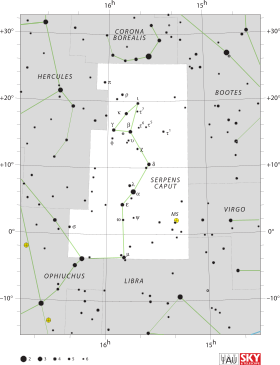| Observation data Epoch J2000.0 Equinox J2000.0 | |
|---|---|
| Constellation | Virgo |
| Right ascension | 14h 57m 33.251s [1] |
| Declination | −00° 10′ 03.40″ [1] |
| Apparent magnitude (V) | 5.5[2] |
| Characteristics | |
| Evolutionary stage | Red clump[3] |
| Spectral type | K1III[4] |
| Astrometry | |
| Radial velocity (Rv) | 20.12[5] km/s |
| Proper motion (μ) | RA: +59.929[1] mas/yr Dec.: −26.500[1] mas/yr |
| Parallax (π) | 10.1280 ± 0.1010 mas[1] |
| Distance | 322 ± 3 ly (98.7 ± 1.0 pc) |
| Absolute magnitude (MV) | +0.76[6] |
| Details | |
| Mass | 1.37[2] M☉ |
| Radius | 13.6[1] R☉ |
| Luminosity | 75[1] L☉ |
| Surface gravity (log g) | 2.5[5] cgs |
| Temperature | 4,581[5] K |
| Metallicity [Fe/H] | −0.07[5] dex |
| Rotational velocity (v sin i) | 3.4[5] km/s |
| Age | 4.58[3] Gyr |
| Other designations | |
| Database references | |
| SIMBAD | data |
1 Serpentis (1 Ser) is a red giant in the constellation Virgo with an apparent magnitude of 5.5. It is a red clump giant, a cool horizontal branch star that is fusing helium in its core.[3] It has expanded to over 13 times the radius of the Sun and although it is cooler at 4,581 K it is 77 times more luminous. It is 322 light years away.
The Flamsteed designation 1 Serpentis was given to the star when the constellation Serpens was combined with the constellation Ophiuchus.[7] It was also given the Bayer designation M Serpentis. When Ophiuchus and Serpens were separated into distinct constellations, 1 Serpentis was left over the border in Libra. Since then it has moved slightly and is now in Virgo.[8]
A 10th-magnitude companion star discovered by William Herschel is 86″ away.[9] It is at the same distance as 1 Ser and shares a common proper motion,[10] It is considered likely to be a physical companion,[11] with the two stars separated by 8,600 au.[12] It has a spectral type of G5 IV,[12] and it is slightly smaller and less luminous than the sun.[10]
A much more widely-separated 10th-magnitude star is also listed in multiple star catalogues,[9] but it is an unrelated background object.[13]
References
- ^ a b c d e f g Vallenari, A.; et al. (Gaia collaboration) (2023). "Gaia Data Release 3. Summary of the content and survey properties". Astronomy and Astrophysics. 674: A1. arXiv:2208.00211. Bibcode:2023A&A...674A...1G. doi:10.1051/0004-6361/202243940. S2CID 244398875. Gaia DR3 record for this source at VizieR.
- ^ a b Luck, R. Earle; Heiter, Ulrike (2007). "Giants in the Local Region". The Astronomical Journal. 133 (6): 2464. Bibcode:2007AJ....133.2464L. doi:10.1086/513194.
- ^ a b c Soubiran, C.; Bienaymé, O.; Mishenina, T. V.; Kovtyukh, V. V. (2008). "Vertical distribution of Galactic disk stars. IV. AMR and AVR from clump giants". Astronomy and Astrophysics. 480 (1): 91. arXiv:0712.1370. Bibcode:2008A&A...480...91S. doi:10.1051/0004-6361:20078788. S2CID 16602121.
- ^ Houk, N.; Swift, C. (1999). "Michigan catalogue of two-dimensional spectral types for the HD Stars, Vol. 5". Michigan Spectral Survey. 5. Bibcode:1999MSS...C05....0H.
- ^ a b c d e Massarotti, Alessandro; Latham, David W.; Stefanik, Robert P.; Fogel, Jeffrey (2008). "Rotational and Radial Velocities for a Sample of 761 HIPPARCOS Giants and the Role of Binarity". The Astronomical Journal. 135 (1): 209. Bibcode:2008AJ....135..209M. doi:10.1088/0004-6256/135/1/209. S2CID 121883397.
- ^ Anderson, E.; Francis, Ch. (2012). "XHIP: An extended hipparcos compilation". Astronomy Letters. 38 (5): 331. arXiv:1108.4971. Bibcode:2012AstL...38..331A. doi:10.1134/S1063773712050015. S2CID 119257644.
- ^ Ian Rdipath. "Serpens, the serpent". Retrieved 2019-08-28.
- ^ Hoffleit, Dorrit; Jaschek, Carlos (1991). The Bright star catalogue. Bibcode:1991bsc..book.....H.
- ^ a b Mason, Brian D.; Wycoff, Gary L.; Hartkopf, William I.; Douglass, Geoffrey G.; Worley, Charles E. (2001). "The 2001 US Naval Observatory Double Star CD-ROM. I. The Washington Double Star Catalog". The Astronomical Journal. 122 (6): 3466. Bibcode:2001AJ....122.3466M. doi:10.1086/323920.
- ^ a b Brown, A. G. A.; et al. (Gaia collaboration) (August 2018). "Gaia Data Release 2: Summary of the contents and survey properties". Astronomy & Astrophysics. 616. A1. arXiv:1804.09365. Bibcode:2018A&A...616A...1G. doi:10.1051/0004-6361/201833051. Gaia DR2 record for this source at VizieR.
- ^ Eggleton, P. P.; Tokovinin, A. A. (2008). "A catalogue of multiplicity among bright stellar systems". Monthly Notices of the Royal Astronomical Society. 389 (2): 869. arXiv:0806.2878. Bibcode:2008MNRAS.389..869E. doi:10.1111/j.1365-2966.2008.13596.x.
- ^ a b Stephenson, C. B. (1960). "A study of visual binaries having primaries above the main sequence". The Astronomical Journal. 65: 60. Bibcode:1960AJ.....65...60S. doi:10.1086/108191.
- ^ Brown, A. G. A.; et al. (Gaia collaboration) (August 2018). "Gaia Data Release 2: Summary of the contents and survey properties". Astronomy & Astrophysics. 616. A1. arXiv:1804.09365. Bibcode:2018A&A...616A...1G. doi:10.1051/0004-6361/201833051. Gaia DR2 record for this source at VizieR.

